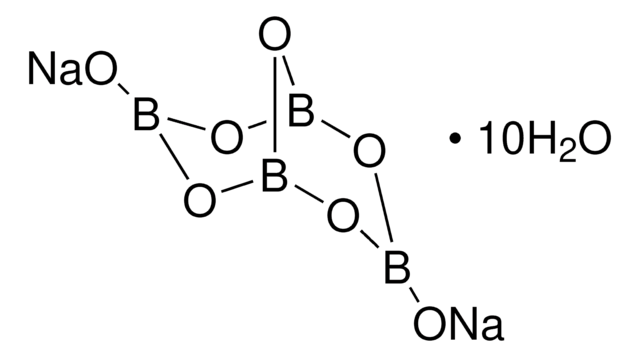31146
Acido borico
puriss. p.a., ACS reagent, reag. ISO, reag. Ph. Eur., buffer substance, ≥99.8%
About This Item
Prodotti consigliati
Grado
ACS reagent
puriss. p.a.
agenzia
USP/NF
reag. ISO
reag. Ph. Eur.
Tensione di vapore
2.6 mmHg ( 20 °C)
Saggio
≥99.8%
Stato
powder or crystals
Impurezze
≤0.005% insoluble in methanol
≤0.05% with methanol-HCl non-volat. matter
pH
3.6-4.0 (20 °C, 4%)
Punto di fusione
160 °C (dec.) (lit.)
Solubilità
water: soluble
Densità
1.440 g/cm3
Anioni in tracce
chloride (Cl-): ≤3 mg/kg
phosphate (PO43-): ≤5 mg/kg
sulfate (SO42-): ≤5 mg/kg
Cationi in tracce
As: ≤5 mg/kg
Ca: ≤10 mg/kg
Cd: ≤5 mg/kg
Cu: ≤5 mg/kg
Fe: ≤1 mg/kg
Mg: ≤5 mg/kg
Pb: ≤5 mg/kg
Zn: ≤5 mg/kg
Stringa SMILE
OB(O)O
InChI
1S/BH3O3/c2-1(3)4/h2-4H
KGBXLFKZBHKPEV-UHFFFAOYSA-N
Cerchi prodotti simili? Visita Guida al confronto tra prodotti
Descrizione generale
Applicazioni
Avvertenze
Danger
Indicazioni di pericolo
Consigli di prudenza
Classi di pericolo
Repr. 1B
Codice della classe di stoccaggio
6.1C - Combustible acute toxic Cat.3 / toxic compounds or compounds which causing chronic effects
Classe di pericolosità dell'acqua (WGK)
WGK 1
Punto d’infiammabilità (°F)
Not applicable
Punto d’infiammabilità (°C)
Not applicable
Elenchi normativi
Forniamo informazioni su eventuali restrizioni prevalentemente per i prodotti chimici. Per altre tipologie di prodotto siamo in grado di fornire soltanto informazioni limitate. Nessuna segnalazione significa che nessuno dei componenti è citato in un elenco. È dovere dell’utilizzatore assicurarsi che il prodotto venga impiegato in maniera sicura e a norme di legge.
EU REACH SVHC Candidate List
EU REACH Annex XVII (Restriction List)
Scegli una delle versioni più recenti:
Possiedi già questo prodotto?
I documenti relativi ai prodotti acquistati recentemente sono disponibili nell’Archivio dei documenti.
I clienti hanno visto anche
Il team dei nostri ricercatori vanta grande esperienza in tutte le aree della ricerca quali Life Science, scienza dei materiali, sintesi chimica, cromatografia, discipline analitiche, ecc..
Contatta l'Assistenza Tecnica.



